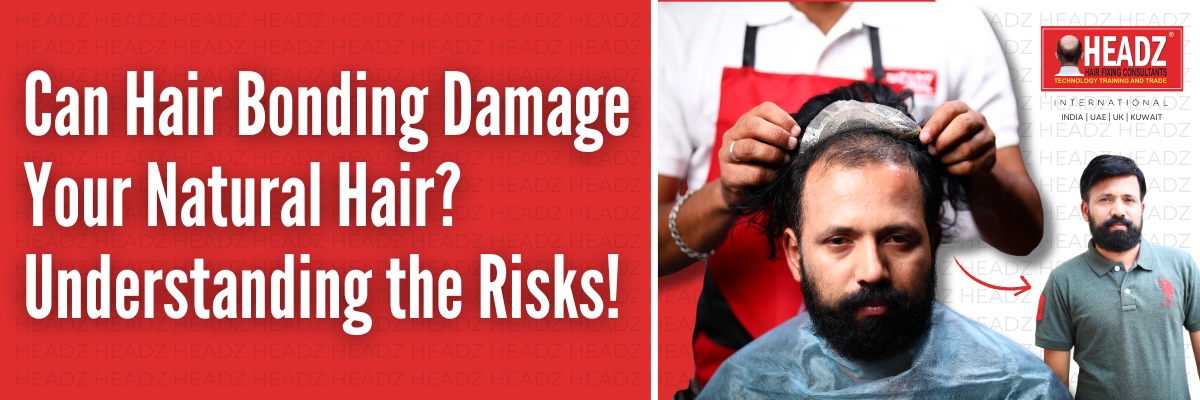Can Hair Bonding Damage Your Natural Hair? Understanding the Risks

- headz
Hair bonding is a popular solution for individuals experiencing hair loss or thinning hair. This non-surgical procedure involves attaching a hair patch near me to your scalp using specialized adhesives, providing an instant boost in hair volume and coverage. While this method has gained immense popularity for its convenience and affordability, many individuals wonder if it can damage their natural hair. In this blog, we delve into the potential risks of hair bonding, offering insights into its impact on your natural hair and scalp health.
What Is Hair Bonding?
Hair bonding is a cosmetic hair replacement technique that involves fixing a hair patch for men or women to the scalp. The process is straightforward: a professional stylist uses skin-friendly adhesives or clips to secure the hair patch. The result is a natural-looking hairline and enhanced hair volume. Unlike surgical procedures, hair bonding is painless, reversible, and requires minimal downtime.
Types of Hair Bonding
- Clip-Based Bonding This method uses small clips to attach the hair patch to your natural hair. It is a temporary option, allowing users to remove the patch whenever they desire.
- Glue-Based Bonding Adhesives are applied to secure the hair patch fixing on the scalp. This method is more durable and provides a longer-lasting result.
- Weave Bonding This involves sewing the hair patch onto braided natural hair, offering a semi-permanent solution.
Each method has its advantages and disadvantages, and the choice depends on individual preferences, lifestyle, and hair condition.
Can Hair Bonding Damage Your Natural Hair?
While hair bonding is generally considered safe, there are some risks associated with the procedure. Let’s explore these potential issues:
1. Damage to Natural Hair
Improper application or removal of a hair patch for men can cause stress on natural hair. Pulling or tugging during the bonding process may weaken the hair strands, leading to breakage or hair fall.
2. Scalp Irritation
The adhesives used in hair fixing can sometimes irritate sensitive scalps. Prolonged use without proper maintenance might lead to redness, itching, or even allergic reactions.
3. Hygiene Concerns
Poor hygiene practices during hair patch fixing can result in fungal or bacterial infections. Regular cleaning and professional maintenance are essential to prevent such issues.
4. Adhesive Build-Up
Using low-quality adhesives or failing to clean the scalp thoroughly can cause residue build-up. This can clog hair follicles, impeding natural hair growth.
5. Temporary Hair Loss
Excessive tension from tightly fixed hair patches can lead to traction alopecia, a condition where hair falls out due to constant pulling.
How to Minimize Risks During Hair Bonding
If you decide to opt for hair bonding, here are some tips to ensure a safe and effective experience:
- Choose a Reputable Salon Always seek professional assistance from a trusted provider offering hair patch near me services. Look for experienced stylists who use high-quality materials.
- Maintain Proper Hygiene Regularly clean the hair patch and your scalp to avoid infections. Use gentle, sulfate-free shampoos for cleansing.
- Perform a Patch Test Before using any adhesive, conduct a patch test to ensure you’re not allergic to the product.
- Follow Removal Instructions Avoid removing the hair patch yourself. Always consult a professional to prevent damage to your natural hair.
- Schedule Regular Maintenance Visit your stylist for periodic adjustments and check-ups. This helps in addressing any potential issues early on.
Benefits of Hair Bonding
Despite its risks, hair bonding remains a preferred choice for many due to its advantages:
- Instant Results: Provides immediate volume and coverage.
- Non-Surgical: No need for invasive procedures or lengthy recovery times.
- Affordable: More cost-effective than hair transplant surgeries.
- Customizable: Hair patches can be tailored to match your hair color, texture, and style.
Is Hair Bonding Right for You?
Hair bonding is ideal for individuals looking for a quick, non-permanent solution to hair loss. It’s especially suitable for people with:
- Moderate hair thinning or bald patches
- Temporary hair loss due to medical conditions
- A preference for non-surgical options
However, if you have extremely sensitive skin or significant scalp conditions, it’s best to consult a dermatologist before proceeding.
FAQs
1. How long does a hair patch last?
A high-quality hair patch can last between 6 months to 1 year with proper care and maintenance.
2. Can I wash my hair with a bonded hair patch?
Yes, you can wash your hair, but use mild shampoos and follow your stylist’s care instructions to maintain the patch.
3. Is hair bonding painful?
No, hair bonding is a painless procedure. You may feel slight discomfort during the initial application, but it subsides quickly.
4. What is the cost of hair bonding?
The cost varies depending on the type of hair patch and service provider. Searching for hair patch near me can help you find affordable options in your area.
In conclusion, hair bonding can be a safe and effective solution for hair loss when done correctly. By choosing a reputable stylist and following proper maintenance practices, you can enjoy a fuller head of hair without compromising your natural hair’s health. Whether you’re exploring hair fixing or searching for hair patch for men services, understanding the procedure’s risks and benefits will help you make an informed decision.
